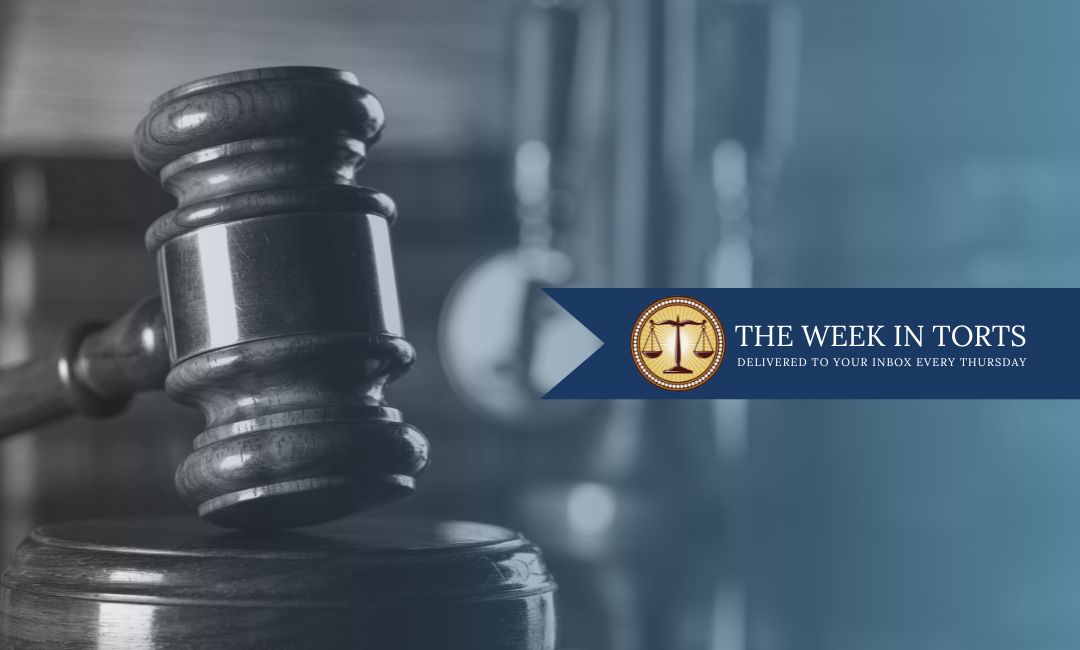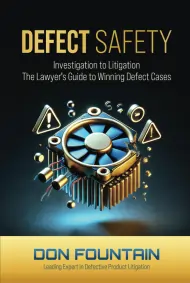The Week In Torts – Cases from December 2, 2022

I would be terrified too.
FLORIDA LAW WEEKLY
VOLUME 47, NUMBER 48
CASES FROM THE WEEK DECEMBER 2, 2022
TRIAL COURT ABUSED ITS DISCRETION IN ALLOWING THE STATE TO EXERCISE A PREEMPTORY CHALLENGE TO STRIKE A BLACK JUROR WHO SAID SHE WANTED TO BE ON THE JURY BECAUSE THE LACK OF POTENTIAL BLACK JURORS ON THE VENIRE “WOULD TERRIFY HER” IF SHE WERE ON TRIAL – TRIAL COURT ERRONEOUSLY LOOKED AT WHAT THE JUROR SAID, INSTEAD OF EXAMINING THE SURROUNDING CIRCUMSTANCES OF THE STATE’S PROFFERED EXPLANATION FOR WHY IT WAS EXERCISING THE STRIKE.
Mays v. State, 47 Fla. L. Weekly D2408 (Fla. 3rd DCA Nov. 23, 2022):
During voir dire, one of the defendant’s attorneys asked if any of the potential jurors really wanted to be on the jury. A black woman raised her hand and expressed her desire to serve based on her worry that the jury might have no black jurors.
The state moved to strike the juror for cause and when asked to explain its reason, the state answered that it appeared the juror had a motive for being on the jury.
Defense counsel responded by asserting that the juror spoke about the defendants’ right to be tried by a jury of their peers, and that the strike was not proper cause challenge. The trial court denied the challenge on that basis. The state then sought to strike the juror peremptorily.
The State responded that because one black male had been selected for the jury panel and that was sufficient, it wanted to strike the juror because of her statement about being terrified if she had a jury that did not look like her. The trial court concluded the State’s reason was race neutral and genuine.
However, the trial court did not seek to question the juror any further. Nor did it give the defense attorney the opportunity to advise the court about how the State’s explanation was pretextual for discrimination. The court said that if the State believed that the juror’s comments demonstrated bias in favor of the defendant, it could have and should have delved further into her motivation for her comments which were clear on their face: an explicitly race – based concern.
Based on the record pattern of exclusion of black jurors and the State’s thin rationale for a preemptory strike, the court found the trial judge’s grant of the State’s challenge was an abuse of discretion and reversed for a new trial.
TRIAL COURT ERRED IN DENYING UNIVERSITY’S MOTION TO DISMISS FOR ALLEGED BREACH OF CONTRACT CLAIM, FINDING THAT SOVEREIGN IMMUNITY DID NOT BAR THE CLAIM—AS THERE WAS NO EXPRESS CONTRACT, SOVEREIGN IMMUNITY DID BAR THE CLAIM
University of Florida Board of Trustees v. Rojas, 47 Fla. L. Weekly D2404 (Fla. 1st DCA Nov. 22, 2022)
The case arose out of fees paid during Covid 19 where the university remained partially closed, but still required students to pay various fees along with their tuition.
Plaintiff filed a class action against the university on behalf of all similarly situated students alleging that the university’s failure to offer on-campus services or refund the related fees for those impacted semesters constituted a breach of contract. They attached the spring 2020 tuition statement, a general state of tuition and various fees estimated for the 2019 -20 academic year, and a copy of the university’s financial liability agreement. He alleged that in the aggregate those documents made up an express written contract between him and the university for specific on-campus resources and services.
The court observed that nothing in those documents obligated the university to provide specific services to any student during any specific time. Without a signature or ratification by any person authorized to enter contracts to bind the university, and the “gratuitous informational statements on a website also could not be legally binding for waiving sovereign immunity.
Without an express written agreement, sovereign immunity barred the action.
TRIAL COURT ERRED IN GRANTING SUMMARY JUDGMENT IN FAVOR OF DEFENDANT ENGINEERING FIRM ON THE GROUND THAT THE PLAINTIFF PRESENTED INSUFFICIENT EVIDENCE TO ESTABLISH THE LOCATION OF A MANHOLE COVER IN THIS NEGLIGENCE CASE.
Del Rio v. Russell Engineering, 47 Fla. L. Weekly D2411 (Fla. 3rd DCA Nov. 23, 2022):
The underlying action arose from an accident where the plaintiff’s vehicle allegedly struck a protruding manhole cover while travel westbound on West Flagler Street somewhere between 16th Avenue and 17th Avenue in Miami Dade County. On the day of the accident, Russell Engineering was performing road work in the area, pursuant to a contract with the FDOT.
The issue on summary judgment centered on the location of the manhole cover and whether it was in the area where the defendant was performing work. The plaintiff unequivocally testified at least three separate times that the manhole cover was located somewhere between 16th and 17th Avenue. He also produced close-up photographs of the manhole cover, which he testified he took at some point after the accident, although he could not recall exactly when. The photographs depicted the cover with a “W” in the center and several white stripes circled around the “W”.
He also testified he could not recall which of the two westbound lanes he was traveling in when he struck the manhole. During his second deposition, defense counsel presented the plaintiff with a Google Earth photograph of the area where the incident occurred and asked whether the photograph showed the manhole cover he struck. He responded, “I believe it is” and then identified the manhole cover in the right lane as the one he thought was involved. That manhole cover had dots embedded across the cover and the word “sewer” displayed on it. The Google Earth photograph also showed a water main manhole cover in the left lane with a “W” in a box in the center.
The defendant moved for summary judgment arguing it was not liable because the manhole cover the plaintiff thought he struck was not located in any westbound lanes of the street near 17th Avenue. In support of its argument, the defendant noted that the manhole cover identified in the photograph exhibit was not the same as the one depicted on the close-up photographs taken by him, and argued that none of the manhole covers located in the area identified resembled the close-up photo.
The trial court granted summary judgment finding that the plaintiff failed to put forth sufficient evidence that the manhole cover he struck was located where he said. The court found that both the plaintiff’s expert and the defendant’s corporate rep agreed that the photograph of the close-up of the manhole was not the equivalent or the same as the two manhole covers that were present and in existence in the westbound lanes where the plaintiff had said they were.
The court reversed the summary judgment. It found that the trial court erred in relying only on the photographic evidence, the testimony of the defendant’s corporate rep and the plaintiff’s expert,while not giving any consideration to the plaintiff’s unequivocle testimony regarding the location. It found a reasonable jury could conclude that the plaintiff’s subsequent identification of the manhole cover was initially mistaken. The court found that the testimony was sufficient to establish a disputed issue of material fact and reversed the summary judgment.
TRIAL COURT ERRED IN DENYING MOTION TO QUASH SERVICE OF PROCESS WHERE RETURN DID NOT INCLUDE NAME OF PERSON SERVED, AS REQUIRED BY §48.21 – NOTATION THAT DOCUMENTS WERE SERVED TO “JANE DOE AS SISTER/CO-TENANT” WAS NOT SUFFICIENT TO COMPLY WITH THE STATUTE, AND PLAINTIFF ALSO FAILED TO PROVE THAT SERVICE OCCURRED AT THE DEFENDANT’S USUAL PLACE OF ABODE AS REQUIRED BY §48.031(1)(a).
Carus v. Cove at Isles at Bayshore Homeowners Association, 47 Fla. L. Weekly D2413 (Fla. 3rd DCA Nov. 23, 2022):
TRIAL COURT ERRED BY DISMISSING FIRST PARTY BAD FAITH ACTION BASED ON DETERMINATION THAT CRN FAILED TO COMPLY WITH STATURORY REQUIREMENTS.
Lugassy v. United Property, 47 Fla. L. Weekly D2418 (Fla. 4th DCA Nov. 23, 2022):
In another case challenging a Civil Remedy Notice, this time the plaintiff won.
The plaintiff In this first-party homeowners insurance case filed a Civil Remedy Notice alleging violations of §624.155 and §626.9541, and listing the specific statutory provisions that the insurance company allegedly violated. It also named the individuals involved and referenced the specific policy language relevant to the claim. The CRN also gave a detailed recitation of the facts surrounding the violation explaining the insurer’s missteps. The insurance company responded, and acknowledged receipt of the estimates and the appraisal which was far in excess of what it had paid.
The trial court determined the CRN was invalid because the “cure” amount was unclear.
The appellate court rejected that determination because Florida law does not require a CRN to include a specific cure amount. The court reversed the dismissal of the order and remanded to allow the homeowner plaintiffs to pursue their bad faith action.
WHEN AN AGGRIEVED PARTY ACCEPTS THE JURY WITHOUT RENEWING OBJECTIONS BEFORE THE JURY IS SWORN, IT FAILS TO PRESERVE ANY ARGUMENTS REGARDING VOIR DIRE CHALLENGES.
Terry v. State, Fla. L. Weekly D2432 (Fla. 1st DCA Nov. 23, 2022):
GOOD DISCUSSION OF PROXIMATE CAUSE AND THE COURT’S DECISION IN GOODING – PLAINTIFF IN TOBACCO CASE REQUIRED TO PRESENT EVIDENCE THAT DEFENDANT’S DESIGN OR DEFENDANT’S FAILURE TO WARN WOULD HAVE MORE LIKELY THAN NOT CAUSE THE DECEDENT TO SUFFER HIS ULTIMATELY FATAL LUNG DISEASE.
R.J. Reynolds v. Nelson, 47 Fla. L. Weekly D2436 (Fla. 1st DCA Nov. 23, 2022):
In this tobacco case, the plaintiff failed to introduce any evidence that a warning would have in any way effected his smoking of the defendant’s cigarettes or that a defect in the cigarettes caused his COPD. Despite the lack of any evidence, the trial court denied defendant’s motion for directed verdict.
The court first reiterated that strict liability is not “liability without causation”. The key law on causation is still the Florida Supreme Court’s decision in Gooding v. University Hospital which held that a plaintiff must show that an injury “more likely than not” resulted from the defendant’s negligence in order to establish proximate cause. Gooding is still good law. As such, the plaintiff was required to present evidence that the defendant’s design or failure to warn of the health risks of smoking prior to 1969 would have “more likely than not” caused him to suffer his ultimately fatal lung disease.
Here, there was no evidence presented to support the plaintiff’s causation claim. The undisputed evidence showed that the plaintiff had not read the instructions, rendering the failure to warn ineffective as the proximate cause of the plaintiff’s injuries. There was also no evidence presented that had the decedent been warned, that he would have read the warnings and stopped smoking in the relevant time period.
The plaintiff also failed to present any evidence that the defendant cigarettes had a “design” defect that proximately caused him to suffer injury in the relevant time period. To prove a design defect, a plaintiff must show that “but for the defect, the injury would not have occurred.”
There was no defect in the defendant’s product. It was designed to be “inhalable” and to contain nicotine. The essence of strict liability based on a defect, is that the product reaches the consumer with something wrong with it.
There was no competent evidence that something was wrong with the defendant’s product. Most importantly, regardless of whether a rational jury could find that the design was defective, the plaintiff did not present any evidence that the defendant’s design involved nicotine manipulation that caused the decedent’s illness. None of the defendant’s experts could testify that any of the alleged manipulation of the nicotine had a probative link to the decedent’s COPD, much less more likely than not.
The trial court erred in denying the motion for directed verdict and the court reversed for entry of judgment for the defendant.


